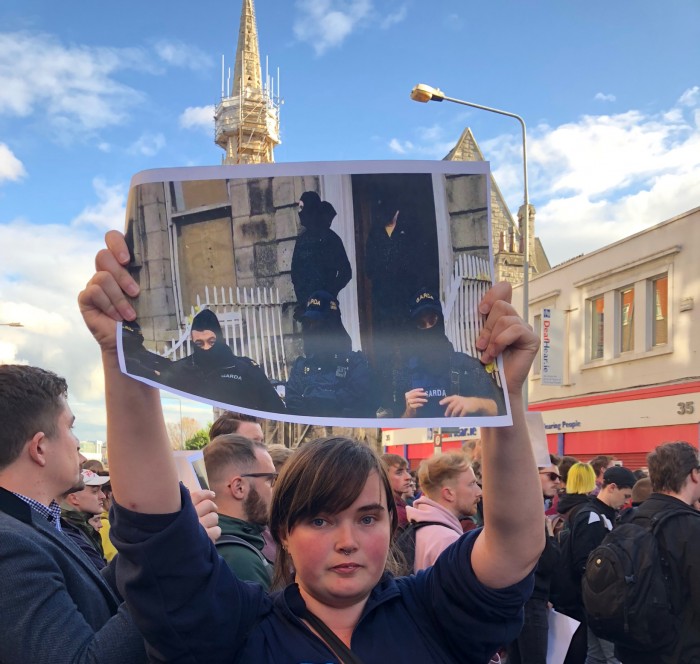In Dublin today, an intensifying housing crisis is provoking a dramatic public response. Activists, spearheaded by groups like Dublin Central Housing Action, occupy empty properties, draping banners from windows sarcastically proclaiming “10,000 welcomes from 10,000 homeless.” They organize tenants to contest illegal evictions, door knocking in neighborhoods where renters are precariously subject to landlord whim. They research property registers and records, and in guerilla blogs such as “Slumleaks,” they shine a light on negligent landlords who hoard properties and leave them derelict. They march through historic city streets—canyons of Georgian brick and wet pavement—disrupting traffic and chanting, “Housing is a human right.”
Swelling community disquiet about a seemingly out-of-control housing market of hyperinflating rents, everyday evictions, and lucrative new forms of accommodation intended to fleece students recently reached fever pitch when 10,000 people assembled in Dublin’s city center on 3 October to protest the government response to the crisis. State policy is widely seen to favor private developers and to be constrained by the neoliberal imperative that property be a source of profit. A day after the public assembly, the Dáil Éireann passed a cross-party resolution declaring a national housing emergency. Thus, exactly 10 years after the fact, the “ghost estates” and “underwater” mortgages of the 2008 global financial meltdown have found an uncanny and irrational echo in a country now instead facing severe housing shortage, extortionate rents, the predations of vulture capital funds, and the high-tech financialization of housing by the likes of Airbnb.
Matters often thought to be private and domestic, such as the quiet and happy occupation of one’s home (and even the battle against the mold on its walls), erupt into public view, generating a genuine crisis of confidence in Ireland’s contemporary political economic order. Even as the country prepares democratically to elect a new president, the nature of Irish democracy is called into question by the perlocutionary affects and effects of public occupation, protest, and assembly (Butler 2015). More than a question of the political economy of sheltering a population, the crisis triggers questions about the moral compass of contemporary Irish culture in relation to its own history. The public is moved by a moral allegory of national struggle that connects contemporary housing politics to prior moments of domination and dispossession.
Public anger was especially catalyzed by a confrontation between activists occupying a vacant home in north Dublin and privately hired heavies in balaclavas acting on behalf of the property owner. The heavies, who used a power saw to break into the barricaded building, were escorted by Gardaí (police) who were themselves masked. The building had been held by the occupiers against a court order legally licensing their removal. When word spread via social media that masked men had violently removed the occupiers and that police had arrested the activists, a crowd quickly assembled. The rhetoric of activists turned from a focus on the dispossessed to the nature of the forces dispossessing them. “Who do you protect? Who do you serve?” they chanted at anonymous police who had their faces covered.
This confrontation yielded a series of images laden with historical resonance, images that surfaced collective memory of both relatively recent traumas and those from a not-forgotten colonial past. They iconographically evoked dramas of dispossession both near and far (see Figure 1).
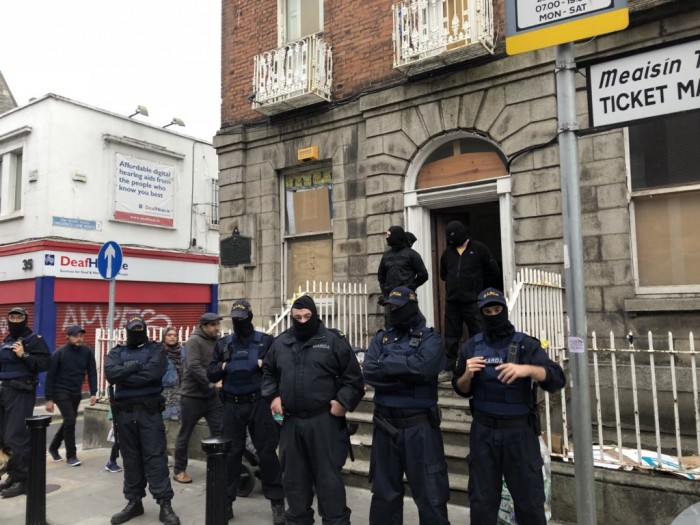
Figure 1: Irish Garda police providing protection for privately hired thugs evicting squatters from Dublin property, 11 September 2018 (© Jack Power).
Rapidly circulating on social media and through mainstream news outlets, the images of masked men turning advocates out of an unused property—under the protection of the police—have quickly become iconic of the crisis as a whole. A hastily organized demonstration the day after the eviction featured printed placards condemning a “garda landlord alliance” (see Figures 2 & 3).
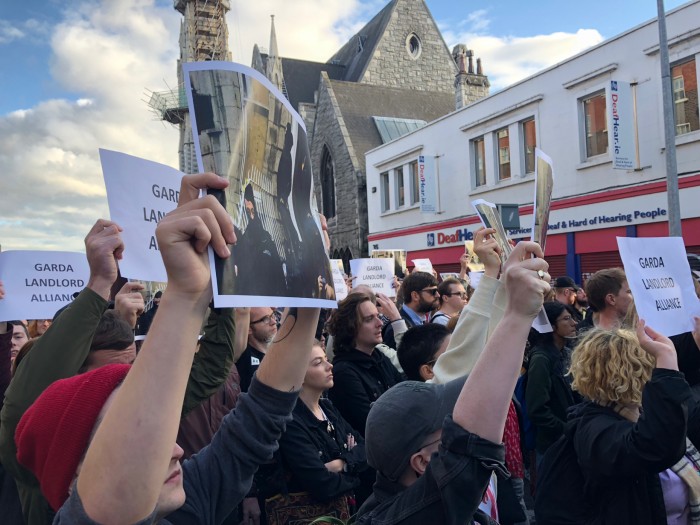
Figure 3: Dublin protestors decry the “Garda Landlord Alliance,” 12 September 2018 (© Thomas Strong).
Activists asked: Are the guards there to protect a peaceful public? Or do they act in defense of the vested interests mining everyday dwellings for financial gain? The question was rhetorical of course. The evidence of the state abandonment of the community’s right to make the city a home is all around, as public properties are sold off in government orchestrated development schemes, and as the very idea of social housing seems to have become nearly unthinkable under the reigning order of political thought. The image of a masked police force protecting masked men attacking housing activists is a poignant icon of the lack of accountability of government in relation to the people whose policies it harms.
But the images were especially potent because of the moral history they allegorize. Many activists and their sympathizers immediately drew comparison to the history of dispossession under British rule (see Figure 4).
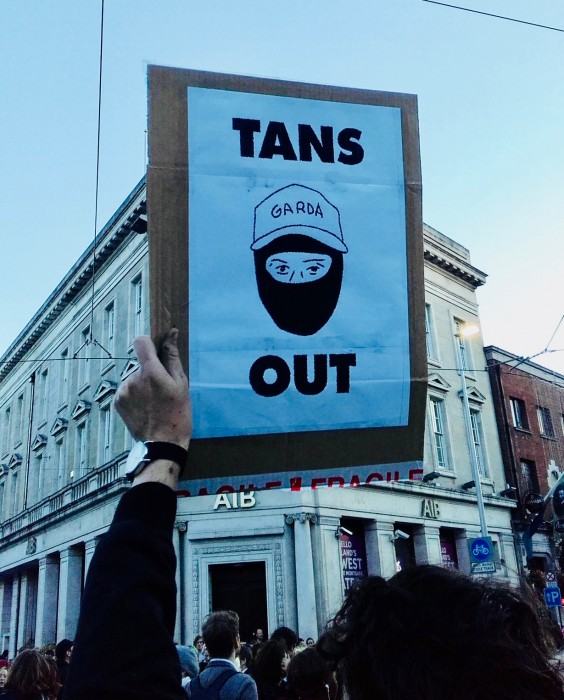
Figure 4: Protest sign evoking the Black and Tans, a British constabulary force known for brutal attacks on Irish civilians during the Irish War of Independence, 12 September 2018 (© Tom Maher).
By comparing it to the colonial area, activists seek to shame and delegitimate the state defense of private property to the exclusion of those in need. The equation of past and present also invites reflection on contemporary forms of global inequality that subject renters living cheek-by-jowl in north Dublin to the forces of transnational finance. The unstated implication is obvious: Is Ireland today but a client state of corporate capital?
But the register of historical meaning is not exhausted by reference to a colonial past. The masked men had arrived to the occupied property in an unmarked, white van without current registration and exhibiting UK license plates. Already, it was immediately apparent that Gardaí were willing to overlook a violation of law (regarding motor vehicle licensing) to assist in violence against peaceful activists. It was known that property owners in the neighborhood, people whom activists label slumlords because of the moribund and exploitative condition in which they keep their properties, were having trouble finding bodies to do their dirty work for them. In prior confrontations with activists (the linked news item features a photograph of your corresponding author), landlords had marshaled local force to put out politicized squatters. As public sentiment has turned, local community members have become reluctant to be seen assaulting sympathetic housing activists, even those illegally occupying private, but unused, property. Thus, rumor spread that the masked “goons” had been hired in from “the North,” and were likely members of the Ulster Volunteer Force, a loyalist paramilitary group in Northern Ireland. The resonance was clear: complicity of the state with extrajudicial enforcement of an oppressive political order.
Leading up to and following these events, activists and organizers have reflected on the effectiveness of their tactics and sought to lace them together into a political strategy of sorts. Much activist energy is devoted to assisting people in emergencies—the newly evicted, those facing illegal rent hikes, homeless families. On a weekly, even daily, basis, various organizations representing specific neighborhoods or communities of interest (such as students) organize to help people cope with a dire housing situation. The publicized occupation of vacant properties began over the summer of 2018 as a way of intensifying public attention. These tactics have indeed drawn the attention of mass media and mainstream political parties. Some detractors contend, however, that this new focus on empty properties and occupation thereof threatens to bring increased surveillance on squatters who have long quietly occupied them. Some anarchists have declared the recent occupations to be merely “stunts” that will not upend the political status quo but will simply bring down more state violence on those living at its interstices.
Another fault line opens between the decentralized and ad hoc actions of this type of housing activism, and the organized political and legislative initiatives favored by mainstream political parties. Might the energy of housing activists be watered down by the involvement of mainstream politics? This question was especially provoked by the presence at a housing rally of the former Tánaiste of Ireland, the Labour politician Joan Burton. Burton had previously been part of a failed criminal case against activists involved in the last substantial eruption of public anger at government when it attempted to privatize Ireland’s water supply.
Ultimately, the significance of these housing activist actions is magnified by the historical allegory that constellates them into a kind of moral story. Ad hoc, make-do, scrappy grassroots activism achieves national significance not only by directly confronting the force and violence of the state and its property-owning classes but also by turning a kind of “cultural intimacy”—the implicit moral code of the nation—against the pretext of legitimacy the state usually takes for granted (Herzfeld 2005). The occupations continue.
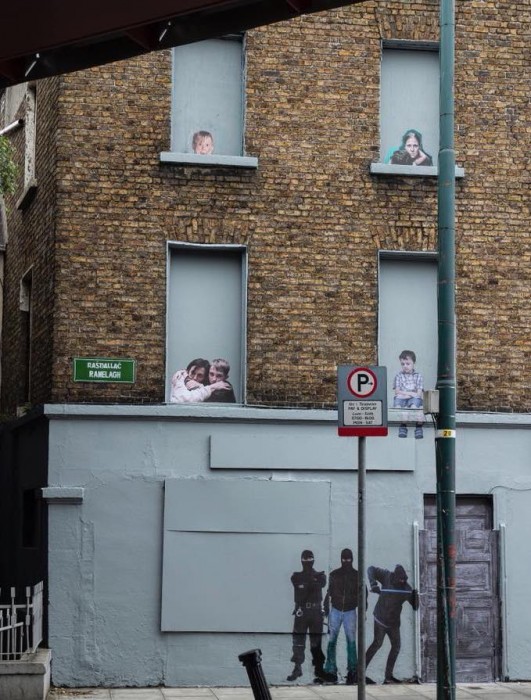
Figure 5: Dublin mural by Subset, 20 September 2018 (© Subset).
Thomas Strong lectures in the Department of Anthropology at Maynooth University, Co. Kildare, Ireland.
References
Butler, Judith. 2015. Notes toward a performative theory of assembly. Cambridge, MA: Harvard University Press.
Herzfeld, Michael. 2005. Cultural intimacy: Social poetics in the nation-state. London: Routledge.
Cite as: Strong, Thomas. 2018. “Dispossession as historical allegory: Observing Dublin’s housing crisis.” FocaalBlog, 12 October. www. focaalblog.com/2018/10/12/thomas-strong-dispossession-as-historical-allegory.
Discover more from FocaalBlog
Subscribe to get the latest posts sent to your email.
